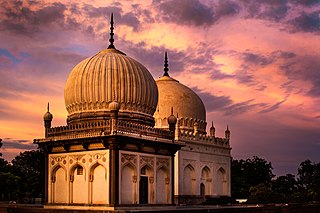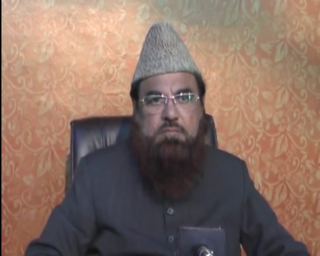Related Research Articles
Bukhari, also spelled as Bokhari, Bukhary or Bukhori, is a common surname in South Asia and in the Muslim world, meaning "from Bukhara".

Burhanpur is a historical city in the Indian state of Madhya Pradesh. It is the administrative seat of Burhanpur District. It is situated on the north bank of the Tapti River and 512 kilometres (318 mi) northeast of city of Mumbai, 340 kilometres (211 mi) southwest of the state's capital city of Bhopal. The city is a Municipal Corporation.

The Masjid-i-Jehan-Numa, commonly known as the Jama Masjid of Delhi, is one of the largest mosques in India.

Jamia Masjid is a mosque in Srinagar, Jammu and Kashmir, India. Situated at Nowhatta in the Old City, the Mosque was commissioned by Sultan Sikandar in 1394 CE and completed in 1402 CE,at the behest of Mir Mohammad Hamadani, son of Mir Sayyid Ali Hamadani, and is regarded as one of the most important mosques in Kashmir. The mosque is located downtown, a central zone in the religio-political life in Srinagar. Thronged by Muslims every Friday, it is a prime tourist attractions of Srinagar.

The Qutub Shahi Tombs are located in the Ibrahim Bagh, close to the famous Golconda Fort in Hyderabad, India. They contain the tombs and mosques built by the various kings of the Qutub Shahi dynasty. The galleries of the smaller tombs are of a single storey while the larger ones are two-storied. In the centre of each tomb is a sarcophagus which overlies the actual burial vault in a crypt below. The domes were originally overlaid with blue and green tiles, of which only a few pieces now remain.

Mufti Mukarram Ahmed is an Indian Muslim religious and literary scholar. Ahmad is the Shahi Imam and Khateeb of Shahi Masjid Fatehpuri Mosque, India's second largest mosque.

Dar-ul-Shifa is a neighbourhood in the Old City of Hyderabad, India, named after the 16th-century hospital it once housed. The location was founded in AD 1591, more than 400 years ago, by Mohammed Quli Qutub Shah, the founder of Hyderabad city. Today it houses a large population of Shia Muslims and comes alive on the days of Muharram and Shia festivals. Most of the households have family members settled abroad, whose remittances increase the quality of life.

The Fatehpuri Mosque is a 17th-century mosque in India located at the western end of the oldest street of Chandni Chowk, in the Old Delhi neighbourhood of Delhi, India. It is opposite the Red Fort on the opposite end of Chandni Chowk.

Mīr Sayyid Jalāl ad-Dīn an-Naqwī al-Bukhārī, better known as Jahāniyān Jahāngasht, was a Punjabi Muslim Sufi saint from South Asia.
The 2010 Jama Masjid attack occurred on 19 September 2010 when two gunmen on a motorcycle fired at a tourist bus near Gate 3 of the Jama Masjid in Old Delhi, India and injured two Taiwanese tourists. The incident provoked fears about security for the upcoming Commonwealth Games in Delhi. About three hours later a car parked approximately 150 meters from the spot caught fire, apparently due to a minor blast.

Jama Masjid, also known as Jumah Mosque or Jami' Masjid, is a mosque in Ahmedabad, Gujarat, India. It was built in 1424 during the reign of Ahmad Shah I. The inscription on the central mihrab commemorates the inauguration of the mosque on the 1st Safar A.H. 827 or January 4, 1424 A.D. by Sultan Ahmad Shah I. The mosque lies in the old walled city, and it is situated outside Bhadra Fort area. The old walled city is divided into separate quarters or pols, and the Jami' Masjid is found on the Gandhi Road. Along the south side of the road, the mosque is a short distance beyond the Teen Darwaza or Tripolia Gate.
Ahmed Bukhari is the 13th Shahi Imam of the Jama Masjid, Delhi.

Abdullah Bukhari was the 12th Shahi Imam of the Jama Masjid, Delhi.

Persian Inscriptions on Indian Monuments is a book written in Persian by Dr Ali Asghar Hekmat E Shirazi and published in 1956 and 1958 and 2013. New edition contains the Persian texts of more than 200 epigraphical inscriptions found on historical monuments in India, many of which are currently listed as national heritage sites or registered as UNESCO world heritage, published in Persian; an English edition is also being printed.

Zubair-ul-Ḥassanc. was an Indian Islamic scholar and fourth emir of Tablighi Jamaat in India.

The Jama Masjid Shamsi also known as Jama Shamsi Shahi is a mosque a major mosque built in the historic center of Budaun, Uttar Pradesh, India.
Syed Usama Shaban Bukhari is the 14th Shahi Imam of the Jama Masjid, Delhi.

Sa'adullah Khan, also spelled Sadullah Khan was the Grand Vizier and Vakil-I-Mutlaq of the Mughal Empire during the reign of Shah Jahan I.
References
- ↑ History of the first Shahi Imam of Jama Masjid, Delhi starting in 1656 AD, culturalindia.net website, Retrieved 18 May 2017
- ↑ Imam Bukhari's family tree, twocircles.net website, Published 15 October 2008, Retrieved 18 May 2017
- ↑ "Shahi Imam of Jama Masjid declares son Syed Shaban Bukhari as his 'successor'". CNBCTV18. 26 February 2024. Retrieved 27 February 2024.